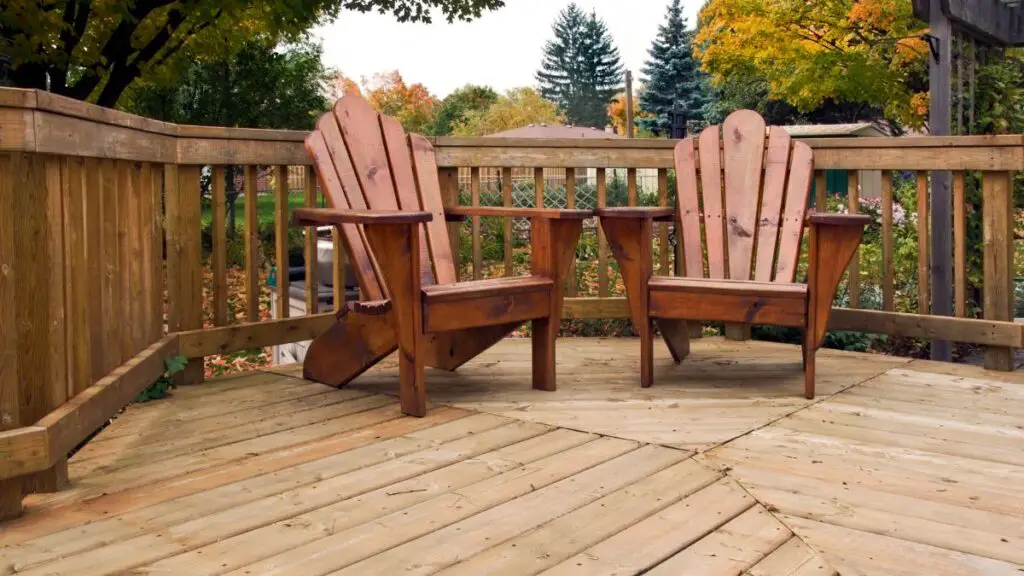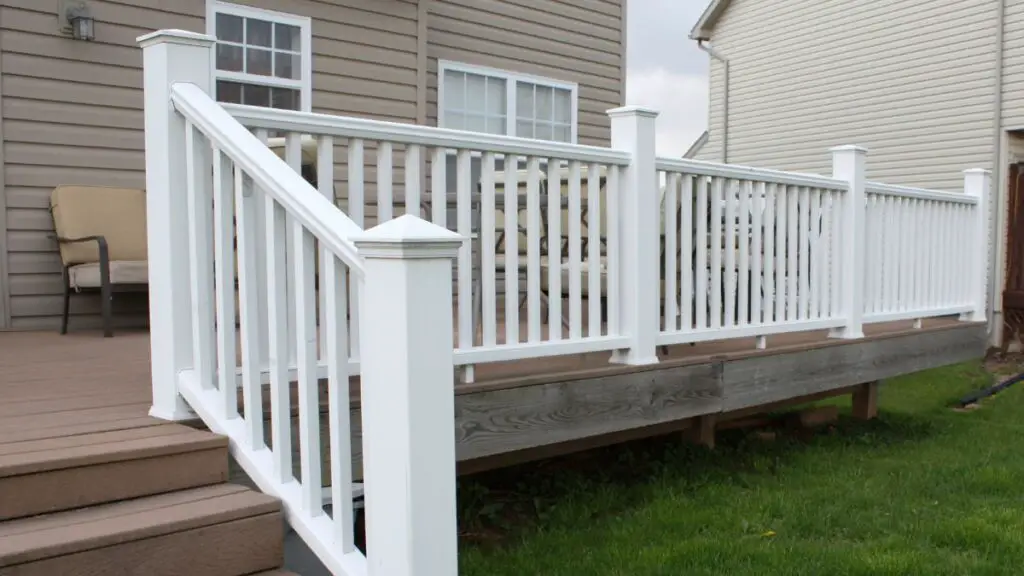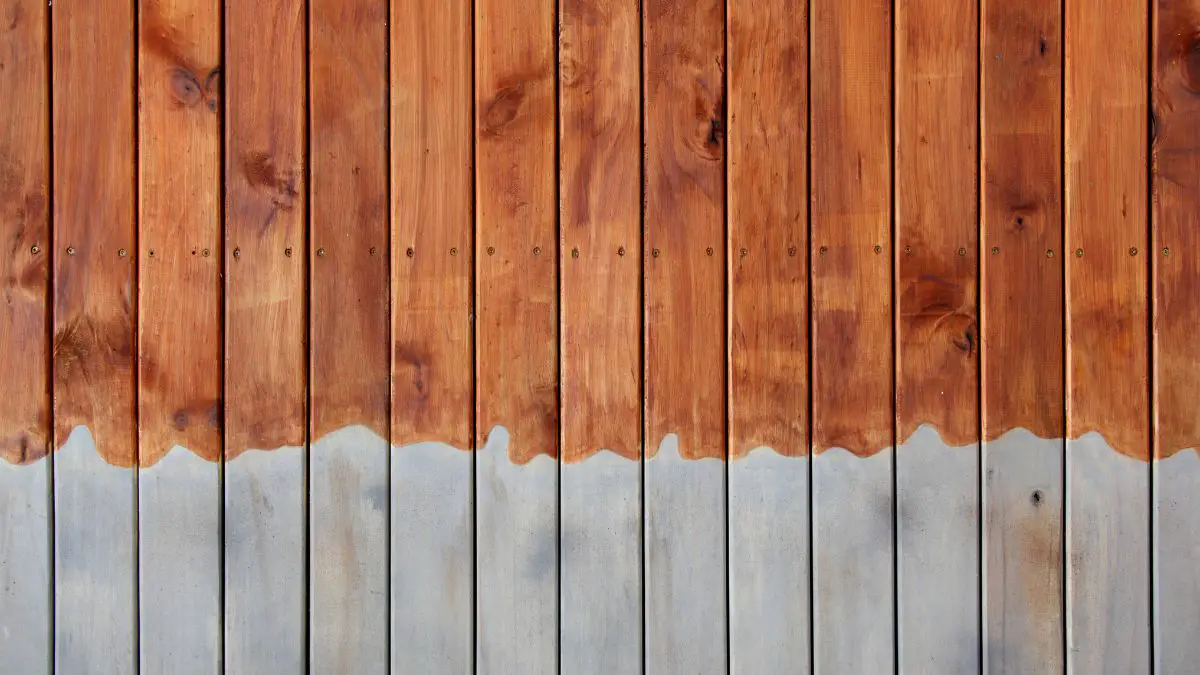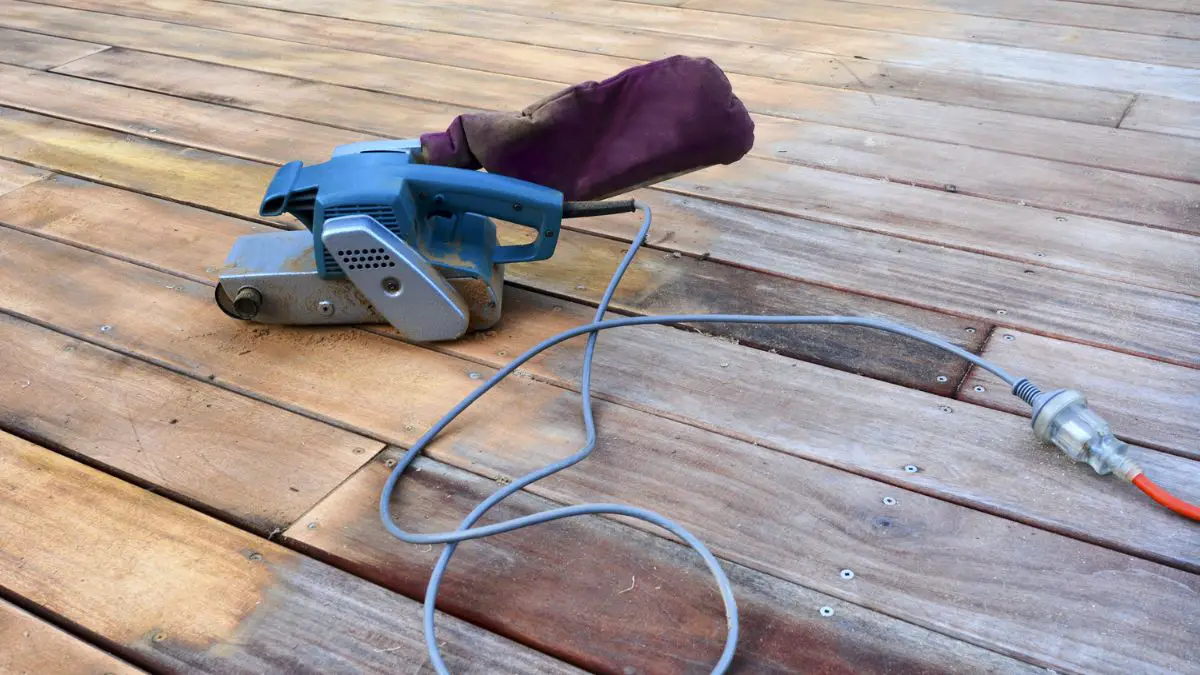Understanding the importance of deck railing height is crucial. It’s not just about aesthetics but safety and additional protection. Too low a railing can be a dangerous fall hazard, especially for children. On the other hand, a too high railing can obstruct your view and detract from the overall look of your deck.
The standard height for a deck railing typically ranges between 36 and 42 inches, but this can vary based on local building codes and the height of your entire deck from the ground.
Navigating the deck railing codes and standards might seem daunting but don’t worry. We’re here to help. These codes and standards are in place to ensure your deck is safe and secure. They dictate the minimum height for deck railings, typically requiring them to be at least 36 inches high.
However, these codes and standards can vary depending on your location. For instance, residential deck railing codes might differ from commercial deck railing codes. It’s essential to check with your local building department to understand the specific requirements for deck railing for your area.
So, whether you’re building a new deck or updating an existing one, this guide will equip you with the knowledge you need to ensure your deck railing is up to code, safe, and aesthetically pleasing. Let’s dive into how tall is a deck railing!
| Key Takeaways |
|---|
| Deck railing height is crucial for safety and functionality. |
| Building codes and standards dictate the minimum height for deck railings. |
| Codes and standards can vary by location and type of deck. |
| The height of your deck from the ground can influence the height of your railing. |
| Various types of deck railings exist, each with its own typical height and pros and cons. |
| Accurate measurement of deck railing height is essential. |
| Non-compliance with building codes and standards can lead to safety risks and legal implications. |
| The standard height for a deck railing is typically between 36 and 42 inches. |
| Understanding and adhering to deck railing height requirements is a commitment to safety, functionality, and aesthetics. |
| Always consult with a deck professional or your local building department if you have questions or concerns. |

Grasping the Concept of Deck Railing Height
It’s the vertical distance from the top of the deck surface to the top of the railing. This measurement is crucial as it directly impacts the safety and functionality of your deck.
But why is the correct deck railing height so important? Well, it’s simple. A railing that’s too low poses a significant safety risk. Imagine leaning against a too-low railing; you could easily topple over, leading to severe injuries. On the other hand, a too-high railing can obstruct your view and detract from the overall aesthetic of your deck.
Factors that Affect the Height of a Deck Railing
- Building codes and standards: As mentioned earlier, the building code for deck railing and standards play a pivotal role in determining the height of your deck railing. These regulations vary by location and type of deck (residential or commercial), so it’s essential to check with your local building department.
- Deck height: The height of your deck from the ground can also influence the height of your railing. Decks that are closer to the ground may require lower railings, while higher decks often require taller railings for safety.
- User safety: The safety of the individuals using the deck is paramount. If children or elderly individuals frequently use your deck, you might consider installing a higher railing for added safety.
- View and aesthetics: The height of your railing can significantly impact the view from your deck. A higher railing might provide more privacy but could also obstruct your view. It’s all about finding the right balance between safety, functionality, and aesthetics.
- Material and design of the railing: The material and design of your railing can also affect its height. Some materials might require extra support and, therefore, a higher railing. Similarly, certain designs might look better with a taller or shorter railing.
Understanding the importance of correct deck railing height and the factors that affect it is the first step in ensuring your deck is safe, functional, and aesthetically pleasing. Before you embark on your deck building or renovation project, take the time to understand these aspects thoroughly. Your deck will thank you for it!
Navigating Deck Railing Codes and Standards
Navigating building codes for deck railing height might seem daunting. But don’t worry; you’re not alone. We’re here to help you understand these regulations, so you can build a deck that’s beautiful, safe, and up to code.
Local, regional, or national authorities establish building codes and standards to ensure the safety and functionality of structures, including decks. These codes dictate the minimum height for deck railings, typically requiring them to be at least 36 inches high. However, these standards can vary.
The International Residential Code (IRC) in the United States stipulates that the minimum height for deck railings on decks more than 30 inches above the ground should be 36 inches.
The International Building Code (IBC) requires deck railings to be 34″ to 38″ high and 42″ high balcony guardrails.
On the other hand, the Canadian National Building Code requires a minimum railing height of 42 inches for decks more than 24 inches above the ground.
These differences in codes and standards by region or country highlight the importance of checking with your local building department before starting your deck project. Whether installing a new deck railing or updating an existing one, understanding your local codes and standards is crucial.
But what happens when you don’t adhere to these codes and standards? Well, the consequences can be severe:
- Safety risks: A deck railing that doesn’t meet the minimum height requirement can pose a significant safety risk, leading to potential falls and injuries.
- Legal implications: You could face fines or legal action if your deck railing violates local codes and standards. In some cases, you might even be required to rebuild your railing or deck.
- Insurance issues: Non-compliance with building codes and standards can also affect your home insurance. Your insurance company might deny your claim if an accident occurs due to a non-compliant deck railing.
- Resale challenges: If you plan to sell your home, a non-compliant deck railing could be a deal-breaker for potential buyers. It could also affect the overall value of your home.
In conclusion, understanding and adhering to deck railing codes and standards is not just a legal requirement—it’s a crucial step in ensuring the safety and longevity of your deck.
Before you embark on your deck building or renovation project, ensure you know your local codes and standards. Your peace of mind—and your deck—will thank you for it!
Mastering the Art of Measuring Deck Railing Height
Now that you understand the importance of deck railing height and the codes and standards that govern it let’s dive into how you can accurately measure your deck railing height.
Tools You’ll Need
Before you begin, gather the necessary tools. You’ll need the following:
- A tape measure: This is your most crucial tool. A retractable tape measure that’s at least 10 feet long is ideal.
- A level: This tool ensures your measurements are straight and accurate.
- A notepad and pen: To jot down your measurements.
Step-by-Step Guide
Follow these steps to measure your deck railing height accurately:
- Start from the Deck Surface: Place the end of your tape measure on the deck surface. This is your starting point.
- Measure Up to the Top of the Railing: Extend your tape measure up to the top of the railing. Make sure your tape measure is straight and level. This is your deck railing height.
- Record Your Measurement: Write down your measurement on your notepad. Taking a few measurements along different railing parts is a good idea to ensure accuracy.
Tips for Accurate Measurement
Here are some tips to ensure your measurements are as accurate as possible:
- Use a Level: Always use a level to ensure your tape measure is straight. A skewed measurement could lead to inaccurate results.
- Measure More Than Once: Measuring more than once in different locations is always good. This can help account for any variations in your deck or railing.
- Check Your Tape Measure: Make sure your tape measure is in good working condition, and the measurements are clear and easy to read.
- Ask for Help: If possible, ask someone to help you hold the tape measure. This can make the process easier and more accurate.
Measuring your deck railing height might seem small, but ensuring your deck is safe and up to code is crucial. Following these steps and tips, you can accurately measure your deck railing height and make any necessary adjustments. Happy measuring!
Exploring the World of Deck Railings
Deck railings come in various styles, materials, and designs, each with its own typical height and set of pros and cons. Let’s explore some of the most popular types of deck railings and their typical heights.
Wood Railings
Wood railings are a classic choice for decks. They offer a warm, natural look that can be painted or stained to match your home.
- Typical Height: Wood railings typically adhere to the standard railing height of 36 to 42 inches.
- Pros: The types of wood railings are versatile, easy to install, and can be customized to fit your style.
- Cons: They require regular maintenance to prevent rot, decay, and damage from insects.
Composite Deck Railings
Composite railings are made from a blend of plastic and wood fibers. They mimic the look of wood but require less maintenance.
- Typical Height: Like wood railings, composite railings usually fall within the standard height range of 36 to 42 inches.
- Pros: Composite railings are durable, low-maintenance, and available in various colors and styles.
- Cons: They can be more expensive than other railing options.
Metal Railings
Metal railings, including aluminum, iron, and steel, offer a sleek, modern look. They’re also incredibly durable and low-maintenance.
- Typical Height: Metal railings typically adhere to the standard railing height of 36 to 42 inches.
- Pros: Metal railings are strong, durable, and require little maintenance. They also offer a sleek, modern aesthetic.
- Cons: They can be more expensive and less customizable than other options.
Glass Railings
Glass railings provide an unobstructed view and a modern, clean aesthetic. They can be framed or frameless.
- Typical Height: Glass railings usually fall within the standard height range of 36 to 42 inches.
- Pros: Glass railings provide an unobstructed view and a modern aesthetic.
- Cons: They can show dirt and smudges easily, requiring regular cleaning. They can also be more expensive than other options.
Cable Railings
Cable railings offer a contemporary look and an unobstructed view. They consist of stainless steel cables stretched across deck railing posts.
- Typical Height: Cable railings typically adhere to the standard railing height of 36 to 42 inches.
- Pros: Cable railings offer a modern, minimalist aesthetic and an unobstructed view.
- Cons: They require regular tightening and are more expensive than other options.
Are Cable Deck Railings a Safe Choice?
Cable deck railings can be a safe choice when properly installed and maintained. They are a popular alternative to traditional railing systems, offering a sleek, modern look and unobstructed views.
However, it’s important to remember that cable railing systems must comply with local building codes and safety standards to ensure adequate strength and stability.
When installing a cable railing system, it’s crucial to use high-quality materials, such as marine-grade stainless steel cables and hardware, and to follow the manufacturer’s installation instructions carefully.
Choosing the right deck railing type depends on your style, budget, and maintenance preferences. By understanding the typical heights, pros, and cons of each type, you can choose a deck railing that not only meets building codes but also enhances the beauty and functionality of your deck. Happy decking!

Decoding the Spacing of Posts on a Deck Railing
The spacing between posts on a deck railing hinges on various factors, including the railing’s height, the railing system type, and local building regulations. Here are some general pointers for post spacing:
- Consult Local Building Codes: Before constructing a deck railing, refer to your local building codes for specifications on deck post spacing, height, and other safety concerns.
- Adhere to Manufacturer’s Guidelines: If you’re utilizing a pre-manufactured railing system, abide by the manufacturer’s guidelines for post spacing and other installation prerequisites.
- Establish the Deck Rail Height: The entire railing’s height can influence the necessary spacing between posts. Railings must be at least 36 inches tall to comply with building code stipulations.
- Maintain a Maximum Post Spacing of 6 Feet: Posts should not be spaced more than 6 feet apart to ensure sufficient support and prevent sagging.
- Consider the Railing System Type: Various railing systems may necessitate different post spacing requirements. For instance, cable railings might require closer post spacing than traditional railing systems.
- Incorporate Intermediate Posts for Extended Spans: If there’s a long span between posts, consider using intermediate posts for extra support.
Always remember adhering to local building code requirements, and the manufacturer’s instructions when installing a deck railing is crucial to guarantee proper support and safety requirements.
The Importance of Adhering to Deck Railing Building Codes
Adhering to deck railing building codes is crucial for several reasons:
- Safety: These codes are designed to ensure the safety of deck users. Adherence to these codes helps prevent accidents and injuries due to falls or structural issues.
- Legal Liability: Compliance with deck railing building codes can shield property owners and contractors from legal liability in case of an accident or injury due to non-compliance.
- Property Value: Properties that comply with deck railing building codes are generally perceived as safer and more desirable, potentially increasing their value and marketability.
- Insurance: Insurance companies may mandate compliance with deck railing building codes as a prerequisite for coverage. Noncompliance can lead to denial of coverage or higher insurance premiums.
- Permitting: Compliance with deck railing building codes is often linked to the permitting process. Failure to secure the necessary permits and comply with building codes can result in fines and legal action.
Adhering to deck railing building codes is vital for safety, legal liability, property value, insurance coverage, and permitting. Collaborating with a qualified contractor and securing the necessary permits is crucial to ensure compliance with deck railing building codes.
Comparing Deck Railing Costs
Comparing deck railing costs is crucial in choosing a railing system that aligns with your budget and fulfills your needs. Here’s a step-by-step guide to help you navigate this process:
- Identify the Material: Deck railings come in various materials, including wood, metal, glass, and composite. Each railing material has its own cost, durability, and maintenance needs.
- Calculate the Length: The length of your deck railing will influence the cost of materials and installation. Measure your deck’s length and determine the linear feet required for the railing.
- Investigate the Cost per Linear Foot: With the material and length in mind, research the cost per linear foot for various railing systems. You can find prices online or consult with local hardware stores or contractors.
- Analyze the Costs: Evaluate the costs of different types of railing systems based on the material and length. Remember, some materials may need more maintenance or have a shorter lifespan, impacting the long-term cost.
- Evaluate Installation and Labor Costs: Installation and labor costs can fluctuate based on the railing system’s complexity and the installer’s expertise. Consider obtaining quotes from different professional contractors to compare installation costs.
- Account for Additional Costs: Additional costs may include permits, taxes, and shipping fees.
By adhering to these steps, you can effectively compare deck railing costs and select a system that satisfies your safety standards, style inclinations, and budget.
How to Secure a Deck Railing
Ensuring a railing is securely installed on a deck is crucial for safety and stability. Here’s a step-by-step guide to help you secure a railing on a deck:
- Mark the Post Positions: Use a measuring tape to identify the post locations on the deck. Ensure the marks are level and evenly spaced.
- Set Up the Posts: Use suitable hardware for your railing system to install the posts. This could include post anchors, brackets, or screws. Ensure the posts are firmly anchored to the deck.
- Fit the Railing Sections: Attach the railing sections between the posts using suitable hardware for your system. This could include screws, bolts, or brackets. Ensure the railing sections are firmly attached to the posts.
- Test for Stability: Once the railing sections are installed, stability test. Give the railing a firm shake to ensure it is secure and does not wobble. Make any necessary adjustments to the hardware or installation if needed.
- Add the Finishing Touches: Once the railing is securely installed, add any finishing touches, such as end caps or decorative elements.
- Regular Maintenance: Inspect and maintain the railing to remain secure and stable. This may include tightening screws or replacing hardware as needed.
By adhering to these steps and maintaining the railing regularly, you can ensure a safe and stable railing on your deck.
FAQs About How Tall is a Deck Railing?
What is the standard height for a deck railing?
The standard height for a deck railing is typically between 36 and 42 inches from the deck surface to the top of the railing. However, this can vary depending on your local building codes and the height of your deck from the ground.
Does the height of the deck affect the required railing height?
Decks more than 30 inches above the ground typically require a railing at least 36 inches high, according to the International Residential Code (IRC). However, local codes may vary, so it’s always best to check with your local building department.
Can I install a railing that’s higher than the standard height?
While you can install a railing higher than the standard or correct height, it’s important to consider the impact on your view and the overall aesthetic of your deck. Additionally, a too high railing can be difficult to lean on comfortably.
Do all types of deck railings have the same height?
Most deck railings, including wood, composite, metal, glass, and cable, typically adhere to the standard railing height of 36 to 42 inches. However, the maximum height can be customized depending on your needs and preferences.
How do I measure the height of my deck railing?
To measure the height of your deck railing, place the end of a tape measure on the deck surface and extend it to the top of the railing. Make sure the tape measure is straight and level for an accurate measurement.
What is a cocktail railing on a deck?
A cocktail railing is a unique deck feature that offers a handy ledge for drinks and snacks. It’s usually a secondary railing system installed atop the primary deck railing, providing a higher ledge, typically around 42 inches tall and wide enough to accommodate glasses, plates, and other items.
What happens if my deck railing doesn’t meet the required height?
If your deck railing doesn’t meet the required height, it can pose a safety risk and may not comply with local building codes. Selling your home could lead to legal implications, insurance issues, and challenges.
When is a railing required on a deck?
The maximum deck height without railing is 30 inches. A deck is over 30 inches off the ground requires a 36-inch tall railing.
Wrapping Up: The Importance of Correct Deck Railing Height
As we wrap up this comprehensive guide, let’s take a moment to recap the importance of correct deck railing height. It’s not just about meeting building codes and standards—it’s about ensuring the safety and functionality of your deck.
A well-designed and correctly installed deck railing can enhance the aesthetic appeal of your deck, provide safety features for you and your loved ones, and even increase the value of your home.
Measuring your railing height accurately is essential, and understanding the factors that affect it can help you make informed decisions about your deck design. From the type of railing you choose to the height of your deck from the ground, each element plays a role in determining the optimal railing height for your deck.
In conclusion, understanding and adhering to railing maximum height requirements is not just a legal obligation; it’s a commitment to additional safety purposes, functionality, and aesthetics. So, take the time to get it right. Your deck—and everyone who enjoys it; will thank you. Happy decking!







